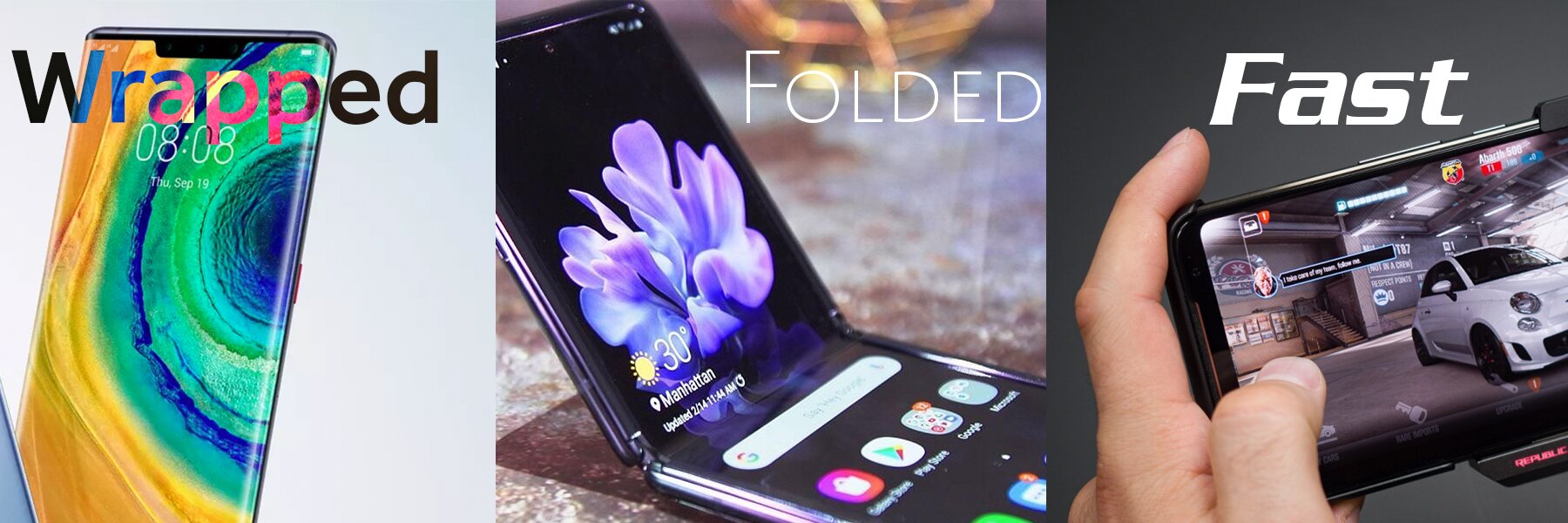The first, and most striking, thing any consumer notices about a smartphone is the display. How bright? How sharp? How big? In many ways, trends in smartphone design can be directly linked to the display, and the advancements in overall display technology.

In 2010, the iPhone 4 launched the “resolution wars”, with a 3.5 inch display at (for the time) an unprecedented 960×640 pixel resolution, a pixel density of 326 pixels/inch. Popular Mechanics cited this as being beyond the resolvable resolution of a human eye, and completely unnecessary; yet ever-increasing display resolutions were the trend for years to come. With the 2020 Galaxy S20 now delivering 3200×1400 pixels on its 6.2 inch display (at 563 pixels per inch!), a stunningly high-resolution display is now entry stakes into the world of smartphones.
Likewise, in 2017, the “notch wars” were launched, with many entrants (the Samsung Galaxy S8, the Essential PH-1, the iPhone X, just to name a few) sporting edge-to-edge displays, with some form of notch to accommodate the front camera, proximity sensor, and speaker. Wide notches, narrow notches, squares, pinholes, mechanically-extending cameras, and others designs were all introduced in the quest to achieve the “100% display” phone. Given that both of these trends have more-or-less peaked, what emerging display trends are now coming to the forefront?
Emerging Display Trends
With the mass adoption of OLED displays, there are three such trends starting – wrapped, folded, and fast, each with a distinct impact on the industrial design and user experience of the phone.
The “wrapped” trend is the so-called waterfall display, where the display is curved potentially all the way around to the rear of the phone. The trend actually started in 2014 with the Samsung Galaxy Note Edge, with one side of the phone beveled downwards to be visible looking at the phone edge-on; now, both edges are fully wrapped with curved glass and display. In fact, the 2020 Huawei P40Pro introduced the concept of “quad curve” displays, where the display not only wraps on the left/right sides of the phone, but on the top and bottom as well.
The purpose of the “wrapped” display is to introduce a new set of user interface possibilities, since the touch sensor and the display are available on all surfaces of the device. The 2019 Huawei Mate 30 Pro had a nearly 90 degree display edge, and the most extreme example was the Xiaomi Mi Mix Alpha, where nearly the entire body of the phone was a single display and the display completely wrapped around the edge.
Limits to Adoption
There are several challenges with the “wrapped” display that may limit ultimate adoption. First, the curved OLED display represents a significant manufacturing challenge, since the display must be laminated to a glass surface that curves vertically (or even past vertical); this translates to extremely high cost of the overall display.
Second, it is expected that the user will have a protective case of some sort on the phone. Covering up the waterfall display, as well as the associated touch sensor/user interface functionality, would obviate the purpose of having such a display in the first place. The protective case would have to leave large swaths of the edges of the phone uncovered, which render them vulnerable to damage. Third, the curved edge tends to optically lens the light emitting from the display. Looking at the display head-on, some users have commented that the bright light lensing from the left/right edges can be annoying.
“Folded”
The “folded” trend has seen a tremendous amount of press over the past year, with the return of the clamshell in the Samsung Galaxy Z and the Motorola Razr, or the phone-tablet hybrids of the Galaxy Fold and the Huawei Mate X. This trend addresses users who desire either more compact phones without sacrificing display area, or users who are looking for even larger screen area when we have reached the upper limit of a pocketable device. This trend promises to offer a wide variety of new form factors – sliders, tubular, origami, just to name a few – that pack far more display area relative to their volume than the glass bricks of the past decade.
Likewise, a tremendous amount of press has been also given to the obvious downsides to foldable and bendable displays – cost and reliability. Every foldable phone that has been launched so far has been at a price point well over $1000 USD, and by now the reliability failures of the Galaxy Fold have become legendary. It is unclear if these two issues will be overcome quickly; by its very nature, a smartphone with a foldable display is a far more complex device to build, and with mechanical complexity comes reliability challenges.
Fast…
The last trend, “fast”, is perhaps the most interesting one. Fundamentally, this trend is about the visual experience of the phone, but in terms of refresh rate, not resolution. A conventional smartphone display refreshes at 60Hz, or 60 times per second.
Advanced smartphone displays are starting to update their images at far faster rates – both the Samsung Galaxy S20 and the ASUS ROG II phones featured 120Hz displays for ultra-smooth video performance for games and potentially improved mobile VR. Several new phones slated for release later in 2020 are rumoured to be sporting 144Hz displays. Fundamentally, as mobile gaming increases in importance and prominence, reducing image blur becomes a requirement of the platform, in the same way that high-refresh PC gaming monitors are standard equipment for a serious PC gamer.
It is a given that 240/360Hz displays will arrive on mobile devices in the next year or two, and Nvidia and Asus have announced a partnership to drive display refresh rates toward 1000 Hz by the end of the decade. Likewise, sync-free displays (like their FreeSync/G-Sync equivalents on the PC side) are also coming to mobile devices, promising to eliminate display tearing and image jitter. In the end, the “fast” trend is about increasing display quality on a mobile device, with mobile gaming as its more important use case.
… & Slow
And mention must be made of the other extreme – slow. With the coming of LTPO-OLED* displays the display can dynamically adjust its display rate from 1Hz (once every second) to 120Hz or greater. The 1Hz mode is incredibly interesting, since it leads to a capability where the display can be “always on” without compromising battery lifetime. This “always on” display was featured prominently in the Apple Watch Series 5, and use of LTPO in smartphones is inevitable. Even if the display is not left “always on,” there are considerable power savings from reducing refresh rates when the image is static, such as on the home screen or when browsing photos.
Unlike the other two trends, there are no significant device manufacturing or reliability concerns with “fast” displays; it is the byproduct of the display technologies being produced for PC gaming monitors. And just like the trend ins display resolution, image quality will continue to get better and better, especially around gaming. The obvious downside is power consumption – the Samsung Galaxy S20 loses about 25% of its battery lifetime with the display at 120Hz vs. 60Hz. A combination of “fast” and “slow” capabilities will likely be the balancing point; by exploiting both, next-generation smartphone displays will offer incredible image quality when playing a game, while taking power consumption to zero when reading a web page.
In conclusion, three recent trends – “wrapped”, “folded”, and “fast” – are driving form factor and capability in smartphone displays. It will be interesting to see how these trends evolve over the next several years:
- Phones become all display, front and back
- A user can fold their phone up into the size of a stick of gum
- Smartphone gaming reaches the same experience desktop or console
Perhaps one will win. Perhaps all of them will. (SS)
* LTPO-OLED is an acronym for Low Temperature Polycrystalline Oxide Organic Light-Emitting Diode, which is charmingly prosaic in its own right.
Samuel Sheng co-founded Sentons in 2011 and is responsible for developing and expanding Sentons’ core technology platforms. A world-renowned expert in CMOS RF and DSP development, Dr. Sheng has extensive experience in architecting and designing leading-edge CMOS RF and DSP chips for silicon tuners, ADSL transceivers, and television technologies, and has been awarded twenty-five patents in the areas of RF tuner and DSL modem design.


